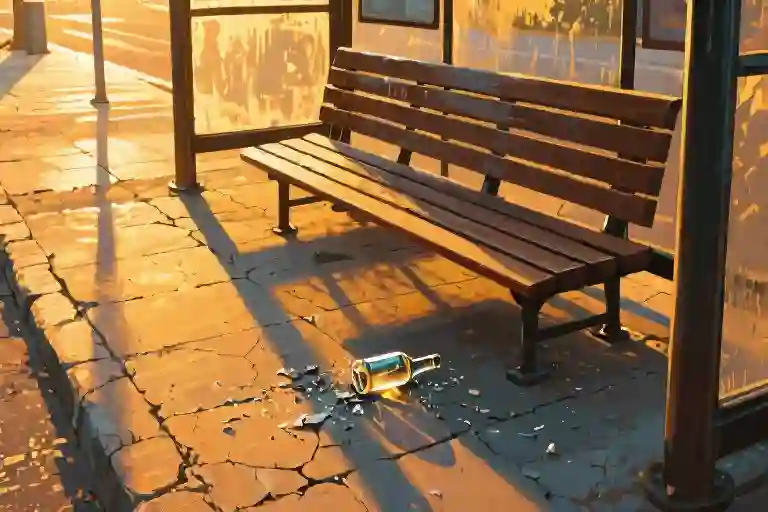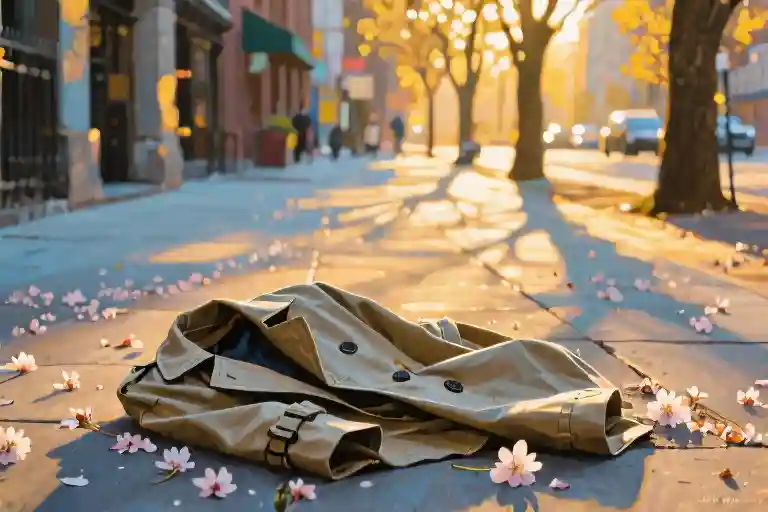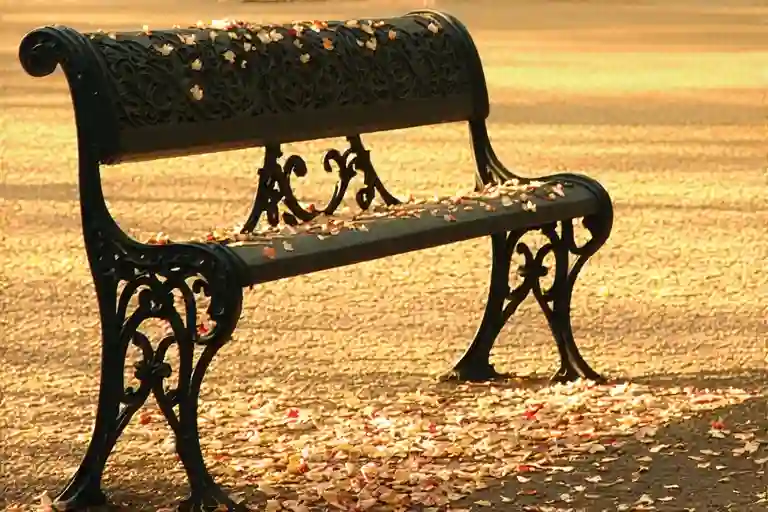The man swayed like a metronome set to the wrong tempo, his grin stretching beyond what human facial muscles should allow. At the bus stop’s edge, his shadow elongated and fractured across the pavement, a distorted companion to his unsteady movements. The late afternoon sun caught the broken bottle in his hand, scattering prismatic shards of light that seemed too beautiful for the moment.
Twenty feet away, my son blew steam from his paper coffee cup, the rising curl mirroring the cigarette smoke from his other hand. We’d claimed our usual spot – third bench from the maple tree, where the slatted wood retains warmth long after the sun dips behind buildings. This was our unspoken ritual after grocery runs: fifteen minutes of outdoor decompression before returning to the apartment’s accumulated tensions.
A bus rumbled past without stopping, its windows reflecting our scene back at us in warped fragments. In one distorted pane I saw the man’s head snap toward three women waiting further down the platform. His posture changed – shoulders rolling forward, neck craning like a predator testing the wind. The women instinctively tightened their circle, handbags shifting to form a leather and canvas barrier between them and the approaching threat.
My son tapped ash into the receptacle between us. ‘Remember that guy who followed us home from the bodega last summer?’ he asked, his voice deliberately casual. The question hung in the air between exhalations, connecting this moment to a dozen others we’d weathered together in these public spaces. Our outdoor conversations always carried this quality – equal parts vigilance and vulnerability, our words sharpened by the awareness that safety is never guaranteed.
The maple leaves above us trembled in a sudden gust, casting dappled shadows that made the scene flicker like an old film reel. For a heartbeat, the man’s looming figure merged with the tree’s shifting silhouette, becoming something both more and less than human. Then reality snapped back into focus as he grabbed the bus pole for balance, his wedding ring screeching against the metal.
On the bench, my son’s knee bounced twice – our longstanding signal when he’s ready to leave. But neither of us moved. Some unspoken understanding rooted us there, witnesses to a moment that demanded to be seen through. The women’s postures told their own story: spines rigid, chins tucked, performing the universal choreography of self-protection. Their eyes never quite met the man’s searching gaze, yet tracked his every movement through lowered lashes.
A siren wailed in the distance, the sound bending around skyscrapers until it became indistinguishable from the man’s sudden laughter. The noise startled pigeons into flight, their wings clapping the air like a misplaced round of applause. My fingers found the grooves in the bench where generations of nervous hands had worn the wood smooth. The man took another swig from his bottle, liquid glistening on his chin as he turned his attention to the youngest woman in the group.
Somewhere beneath my ribs, familiar tension coiled – that particular urban parental calculus measuring risk against responsibility, protection against provocation. The coffee cup in my hand had gone cold, its bitter scent mingling with gasoline fumes and the maple’s first fallen leaves. My son stubbed out his cigarette with deliberate precision, the glowing ember dying against concrete just as the man’s shadow fell across the woman’s shoes.
The Anatomy of a Threat
The man’s smile wasn’t just drunken amusement—it pulled at his face like skin stretched over a skull. That particular grin had a medical name I’d learned during my EMT training: risus sardonicus, the twisted smile of tetanus patients. His version came with darting eyes that never settled, pupils wide enough to swallow the afternoon light. A biological alarm system in my spine began pulsing warnings long before he staggered toward the first woman.
She was rearranging grocery bags when his shadow crossed hers. I saw the exact moment her body recognized danger before her mind caught up—her shoulders lifted slightly, fingers tightening around a bag of oranges. As he leaned in to whisper something, the citrus scent of crushed fruit bloomed in the air when the bag slipped from her grip. The oranges rolled toward the curb in slow motion, each one hitting the pavement with a soft thud that sounded louder than it should have.
My son stirred beside me, the steam from his coffee curling around his face. ‘That guy looks like Jason from the hockey rink,’ he said, tapping ash from his cigarette. Last week, some kid named Jason had pinned a teammate against the locker room wall after practice. ‘Coach said it was just hazing, but his eyes did that same weird thing.’ He made a circling motion near his temple, the glowing tip of his cigarette tracing orange arcs in the dimming light.
Three benches away, the man was now mimicking the woman’s gestures as she tried to gather her scattered groceries. His parody of helpfulness—exaggerated bending at the waist, fingers snatching at air—sent her stepping backward into a puddle. The water soaked through her canvas shoes instantly, the dark stain spreading like ink. Nobody at the bus stop moved to help. We’d all perfected that urban skill of looking without seeing, our collective gaze sliding off the scene like water off waxed canvas.
My son exhaled a stream of smoke that fragmented in the breeze. ‘Remember when you taught me about peripheral vision?’ he asked. Last summer, we’d practiced noticing details at the edges of our sight during long walks home. Now his eyes stayed fixed on his coffee cup, but I could tell he was tracking every twitch of the man’s hands through his lowered lashes. The parenting win felt hollow as the man lurched toward a second woman, his laughter triggering a flight of pigeons from the station roof.
Their wings made a sound like cards being shuffled as the sun dipped behind the bus shelter, stretching all our shadows into grotesque shapes on the pavement.
The Unspoken Rules
The second woman held her phone to her ear with trembling fingers. Her lips moved in practiced repetition – ‘Yes, I’m on my way home now’ – but the screen stayed dark. No call connected. She kept nodding anyway, her free hand clutching the strap of her bag like it might dissolve if she loosened her grip.
I remembered teaching my son to recognize these signs last summer. We’d been sitting on a park bench watching people pass by when I pointed out the subtle tells: ‘See how that man keeps adjusting his waistband? Watch the woman who changed her walking rhythm when those kids got too close.’ My boy had rolled his eyes then, sixteen years old and certain the world operated on basic decency. Now his fingers tapped restless patterns against his knee, his coffee forgotten on the bench between us.
The station’s overhead lights flickered, casting jagged shadows across the ‘See Something Say Something’ poster plastered beside the timetable. The letters blurred as the drunk man lurched toward the third woman, his shadow swallowing the bright yellow safety slogan whole.
Something acidic rose in my throat – not fear exactly, but the metallic taste of recognizing a script we all know by heart. Women become smaller, men pretend not to notice, and the city murmurs this isn’t our business in the rustle of turning pages and sudden interest in phone screens. My son’s knee bumped against mine, warm and alive and suddenly so young.
The second woman’s imaginary conversation grew louder, her laughter sharp as broken glass. A performance we’ve all seen before, one where everyone plays their part except the man who doesn’t follow societal cues. His fingers brushed against the third woman’s elbow – just an accident the gesture claimed – and the air thickened with that particular urban tension where anything might happen next.
I thought about the park bench lessons, how recognizing danger means nothing if you don’t also teach the weight of intervention. The safety poster’s font swam before my eyes, its cheerful yellow now the color of cowardice. My coffee cup trembled in a way that had nothing to do with the arriving bus’s vibration.
The unconnected phone call ended with a too-loud ‘Love you too!’ as the woman ducked onto the bus. Her performance over, mine just beginning. The space between our bench and where the drunk man stood seemed to stretch and contract like living tissue. Somewhere behind us, a child asked ‘What’s wrong with that man?’ and was quickly shushed. The oldest urban safety tip of all: Don’t make eye contact with the chaos.
Yet when my son’s fingers found mine for half a second – sticky with spilled coffee and shaking with adrenaline – I understood the real lesson I’d failed to teach: That see something only matters when someone finds the courage to do something. The safety poster’s letters sharpened into focus as I inhaled to speak, their message finally legible through the gathering dark.
The Moment Everything Shifted
The metallic glint off the man’s collar caught the late afternoon sun at a sharp angle, sending a needle of light directly into my peripheral vision. That split-second refraction created a visual echo – his silhouette seemed to duplicate in my retinas, one figure swaying drunkenly while the phantom image lunged forward. My fingers tightened around the warm paper coffee cup, the heat suddenly registering as both comforting and dangerously distracting.
My son exhaled a slow stream of smoke, his eyes tracking the same scene but processing it differently. The generational divide manifested in our postures – his body remained loose while mine coiled like a spring. That’s when the man’s erratic scanning locked onto us, his head tilting with animal curiosity. The transition from potential threat to immediate danger happened in the space between two sidewalk cracks.
Three sensory inputs registered simultaneously: the acidic tang of sweat cutting through tobacco smoke, the high-pitched whine of bus brakes blocks away, and the damp click of the man’s tongue against his teeth as he reshaped that unsettling grin. My military training from two decades ago surfaced in disjointed fragments – assess exits, identify weapons, protect the civilian. Except now the civilian was my child, stirring his coffee with deliberate calm.
A woman’s shoe scuffed concrete behind us, triggering the man’s attention to snap elsewhere. That momentary disengagement allowed conscious thought to override instinct. The bystander’s dilemma crystallized – intervene and risk escalation, or prioritize our safety through inaction? My knees bent slightly, weight shifting forward in preparation rather than commitment.
When Witnessing Becomes Participating
(Expert intervention sidebar appears at this narrative pause point)
Public safety specialists recommend this decision framework when observing harassment:
- Distract: Create benign interruption (ask for directions/spill change)
- Delegate: Identify allies or authorities to assist
- Document: Record discreetly if situation escalates
The key is maintaining plausible deniability while disrupting the aggressor’s script.
Back on that sunlit bench, the calculus continued. My son’s quiet observation – ‘He’s like Mr. Hendricks from school, just louder’ – reframed the encounter through adolescent eyes. The comparison to his awkward math teacher momentarily defanged the threat, revealing how context shapes perception. But when the man’s fist suddenly clenched around a bus pole, reality snapped back into focus.
That’s when I noticed the other witnesses – a delivery driver pausing his cart, a student lowering her headphones, three office workers exchanging glances. Our collective hesitation hung palpable in the air, each person waiting for someone else to take the first step. The sociology term ‘diffusion of responsibility’ became visceral as seconds stretched taut.
Then the espresso machine across the street hissed like a warning. The sound triggered my son to stub out his cigarette with finality, the gesture somehow both casual and decisive. As he stood, his phone camera activated with an audible click. Not pointed directly, not quite hidden – that perfect ambivalent angle modern kids master instinctively. The man’s head swiveled at the sound, his predatory focus fragmenting into confusion.
We never learned what became of him. The arriving bus swallowed him into its fluorescent belly while the rest of us remained scattered across the pavement, our unspoken solidarity evaporating with the diesel fumes. But for weeks after, I’d catch myself studying strangers’ collars in sunlight, remembering how ordinary objects become signals when the world tilts toward danger.
The toe of my sneaker pivots at a precise 45-degree angle, worn rubber grinding against concrete. That subtle rotation contains entire decision trees – to rise or remain, to speak or stay silent, to become part of the story or remain its audience. The afternoon sun catches the frayed threads of my shoelace, this mundane detail suddenly precious as the world narrows to the drunken man’s unpredictable movements and my son’s steady breathing beside me.
Most safety guides don’t mention how intervention begins in the body before reaching the mind. The slight forward tilt of the pelvis, the unconscious flexing of fingers that once knew combat grips, the way peripheral vision sharpens while everything else blurs. Urban survival lives in these micro-adjustments, the physical poetry of preparation that could swing toward confrontation or retreat.
A pop-up window materializes in my peripheral awareness, one of those modern-day moral dilemmas packaged as interactive content: Choose your bystander action. Option A glows with the false promise of safety through technology – record the harassment discreetly. Option B offers the social gambit of pretending to ask directions. Option C pulses with institutional trust I no longer possess – alert authorities who might arrive too late. The buttons hover like fireflies over the cracked sidewalk, digital ghosts superimposed on an analog crisis.
Beneath this imaginary interface, Claire Thomas’s TIP theory unfolds in a psychologist’s crisp handwriting. Time/Information/Position – the holy trinity of streetwise calculus. How many seconds before the situation escalates? What do I truly know about this man’s intentions? Where exactly am I standing in relation to threat and escape routes? The theory collapses when I notice my son’s thumb unconsciously stroking his phone screen, mimicking my own stress tells.
What blooms between us isn’t fear but its quieter cousin – recognition. The understanding that city parenting means calibrating reactions like a seismograph, measuring each tremor’s potential to become catastrophe. Our outdoor conversations have always been about this unspoken curriculum: reading body language in the checkout line, noting which subway cars feel safest, recognizing when laughter turns predatory. Today’s lesson happens in real time, the curriculum rewritten by a stranger’s unstable orbit.
The folding chair creaks as I redistribute my weight, the sound startlingly loud. Three women have already endured this man’s attention. The fourth potential target hasn’t appeared yet. That’s the math of public safety – not if but when, not who but next. My knees remember their old military precision, locking at just the right angle to spring upward while keeping the coffee cup steady. The paradox of protection: preparing to act while hoping you won’t need to.
Somewhere between the psychology textbook and the pavement, between the digital prompts and my son’s watchful silence, the decision makes itself. Not with dramatic flair but through accumulated micro-movements – the straightening of my spine, the protective arc of my elbow creating space, the clearing of my throat that’s neither challenge nor apology but simple human noise. The kind of sound that says I exist here too.



